Newbie Stage Three: Moving Cards, Realizing What I've Done
Today I reached an exciting milestone with my ZK: I officially had to migrate my desktop collection of physical zettels into my more permanent ZK storage files because there were just so many cards! I didn't migrate them all, as certain categories were ones I reference all the time. Still, it was an exciting moment! My Zettelkasten brain is growing!
That excitement lasted until I started going through my Zettel categories to see which ones I could move into the file drawer. That's when I achieved a Newbie Stage Three insight: "OMG what was I THINKING with some of these categories??!!!" It's humbling to see how the first twenty-some categories I created weren't actually categories at all, but thoughts that now fall within my more established categories. (So many file tabs with one-three cards behind them, oh my!) I can see some re-coding and re-organizing in my future.
Ah, the joys of an evolving system!
Howdy, Stranger!

Comments
hello @jeannelking, thank you for sharing your experience on the Zettelkasten method with us! Is the work you describe above purely paper based? In other discussions you mention to use the Archive, as well. I wonder what you mean by a file drawer - is that analog or digital? These days one can't tell which is which anymore
my first Zettel uid: 202008120915
How many physical cards would you say you are at?
My ZK is both analog and digital. I'm just crazy that way, I guess, but it works great for my purposes - digital searches, analog manipulations (spatial thinking) for writing papers.
I keep one file box on my desk - it's my "working ZK station":
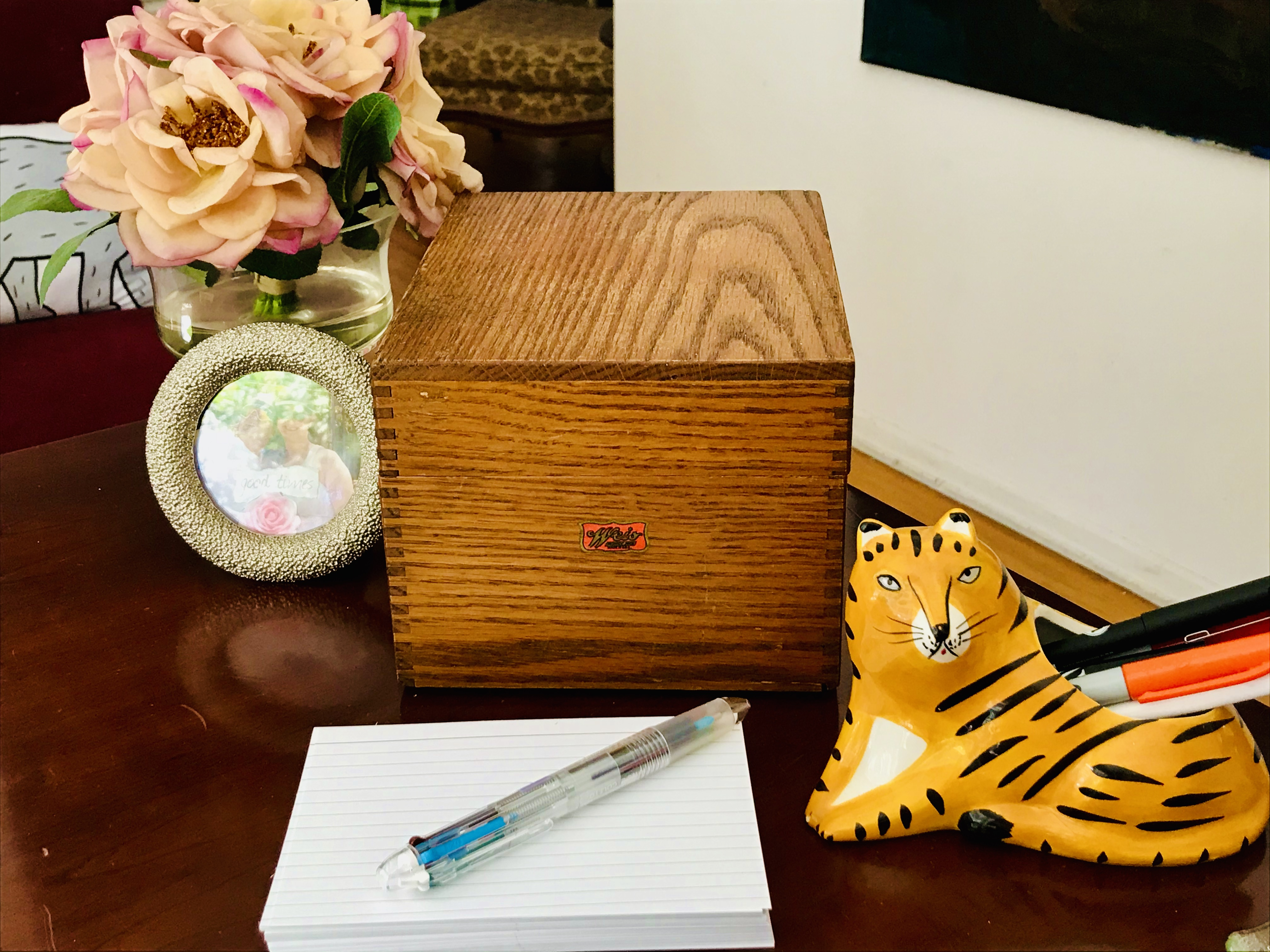
I also have a series of card file drawers for housing my ZK brain as it grows:
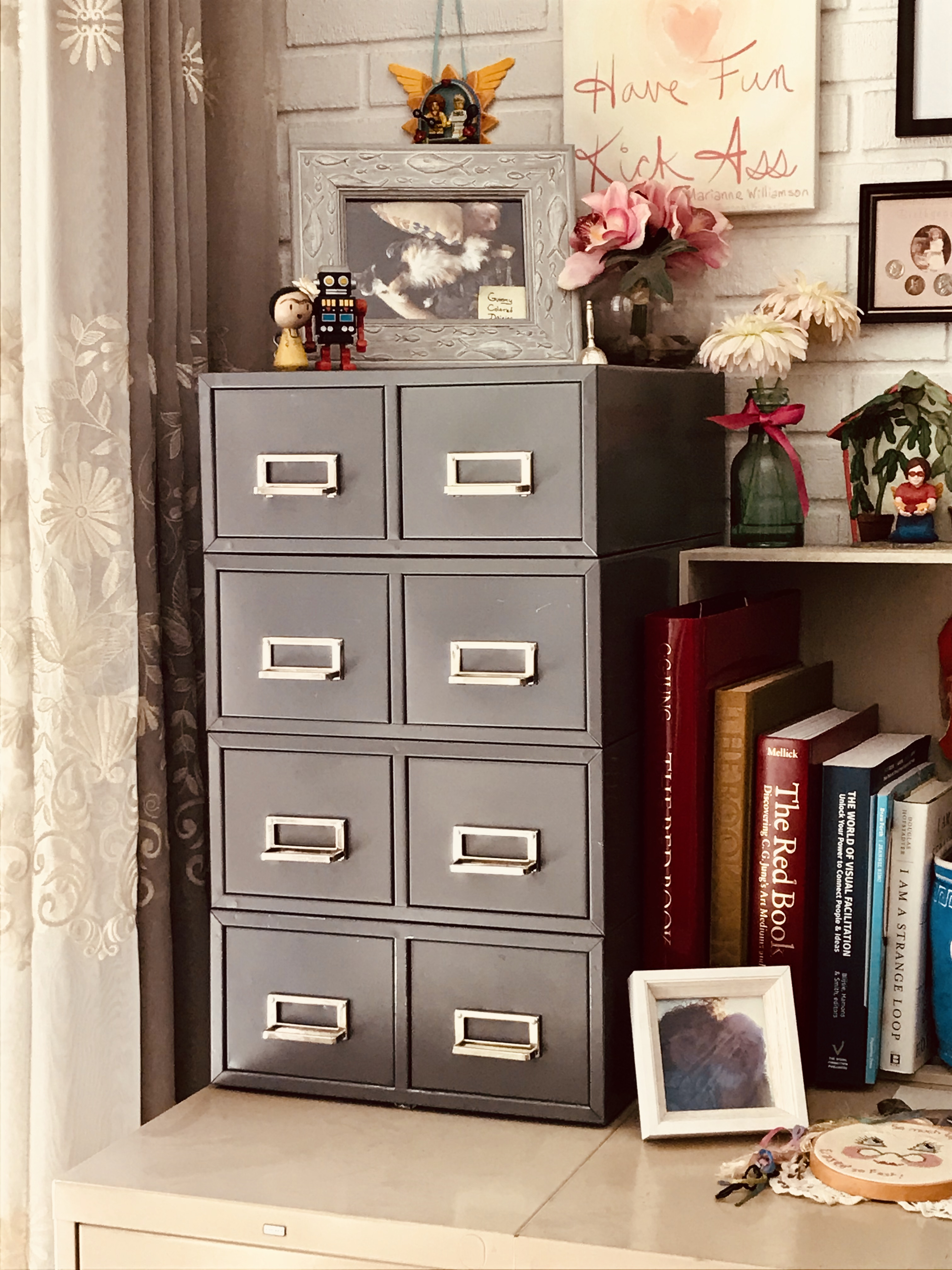
396 physical cards right now.
Holy cats. I'm gonna need a bigger boat.
@jeannelking Thanks for the photos! They bring a little bit of reality into the discussion
Wow! I'm thoroughly impressed. With children around, I can't trust myself with a physical system. But you make it look so appealing!
Could you explain what you mean by "categories"? Are they tags/indexes etc.? And what is your process in making changes to existing notes (e.g. adding new links or tags)? Do you just pull out the physical notes in your archive and 'update' them?
This calls for more pictures! :^D
I view categories as "topic buckets". These are the things that prompt me to create new starting numbers on a card:
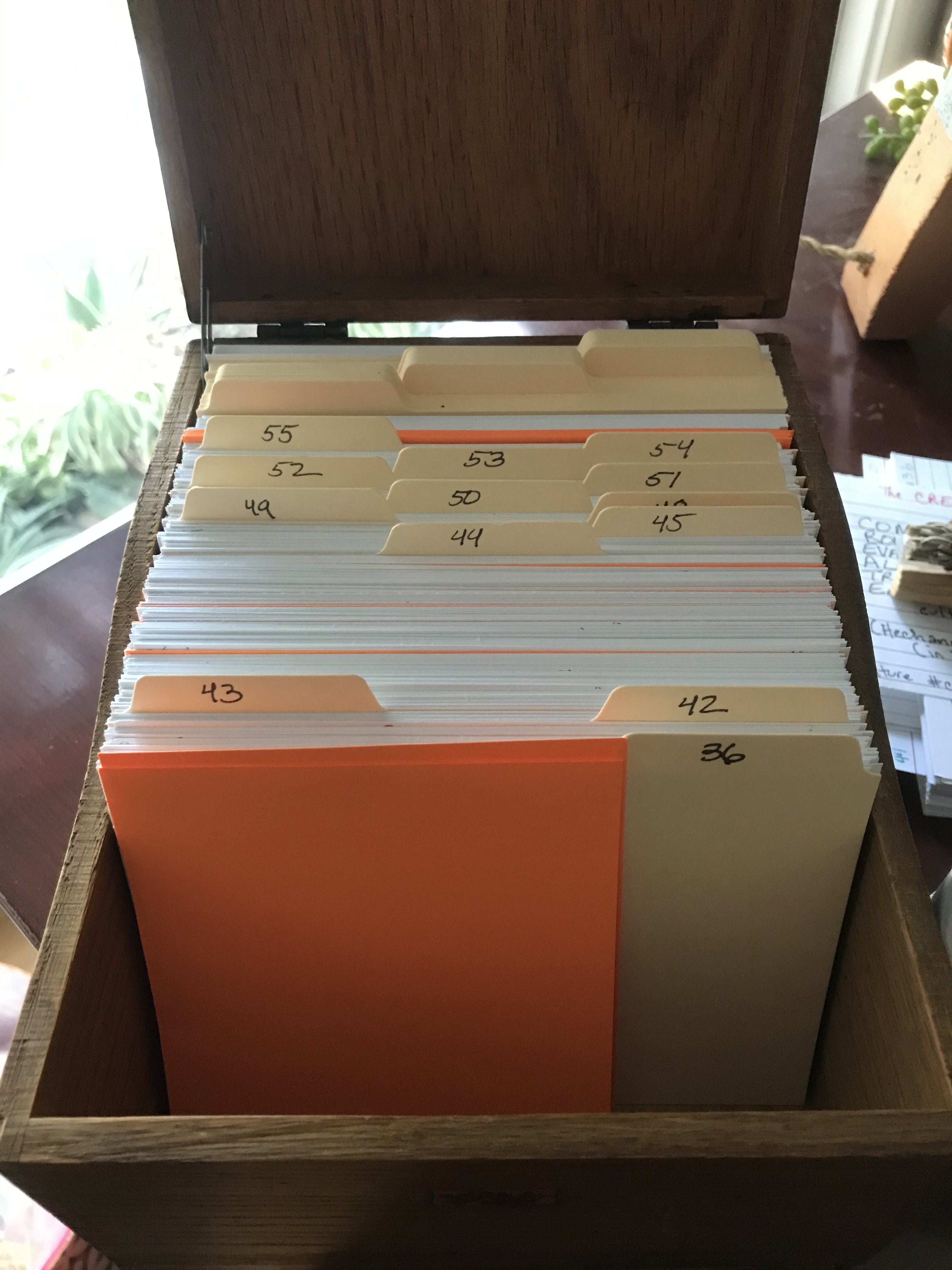
"Creativity" (#43) is a big category in my ZK. Many of those "what was I thinking" categories will actually become sub-cagtegories or contributions to this larger, "Creativity" category. You can see some of the major sub-categories marked with the orange index cards.
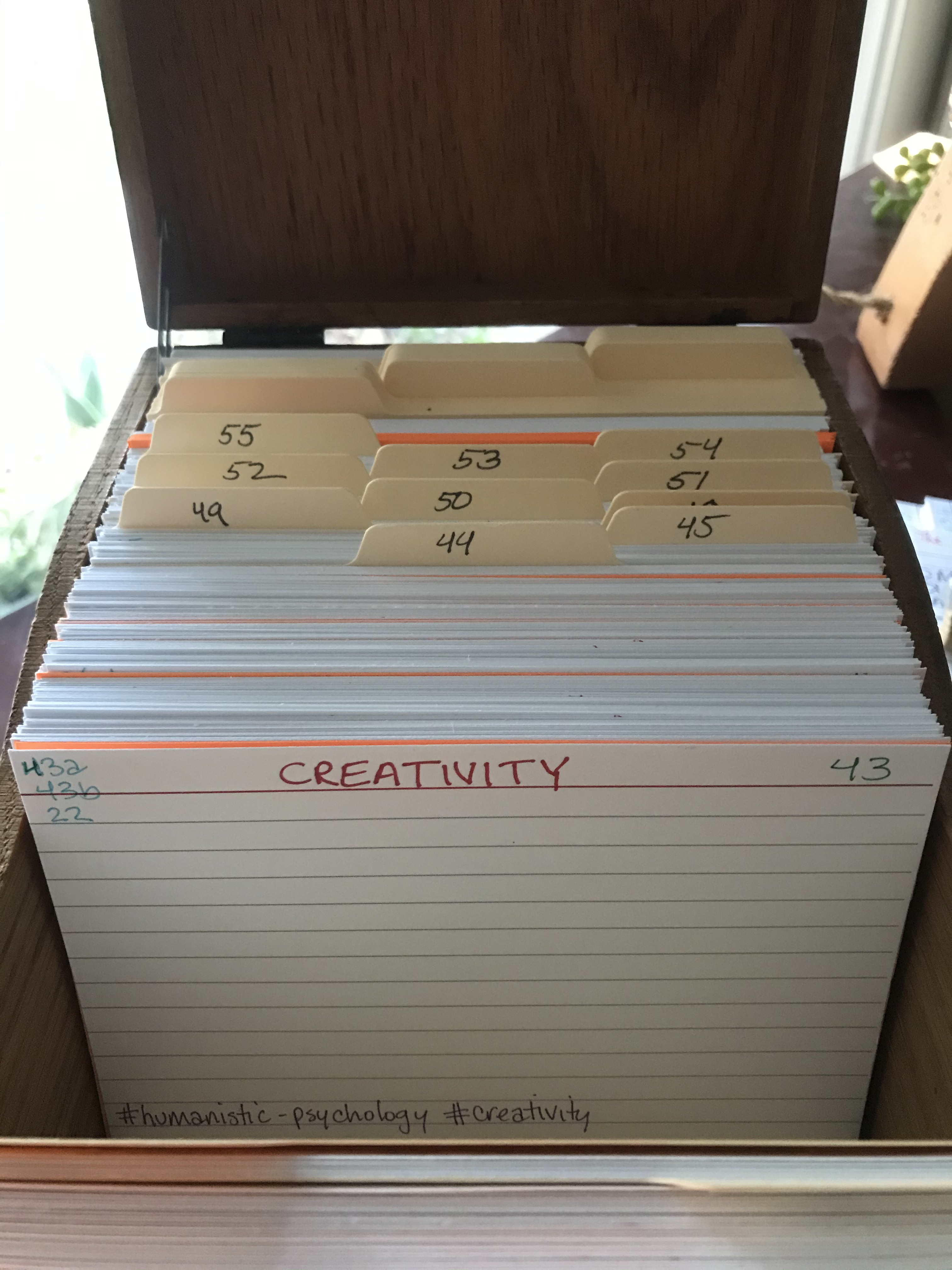
Because I am not only studying creativity, but creativity at work, I chose to create a separate main category for this subject (#36).
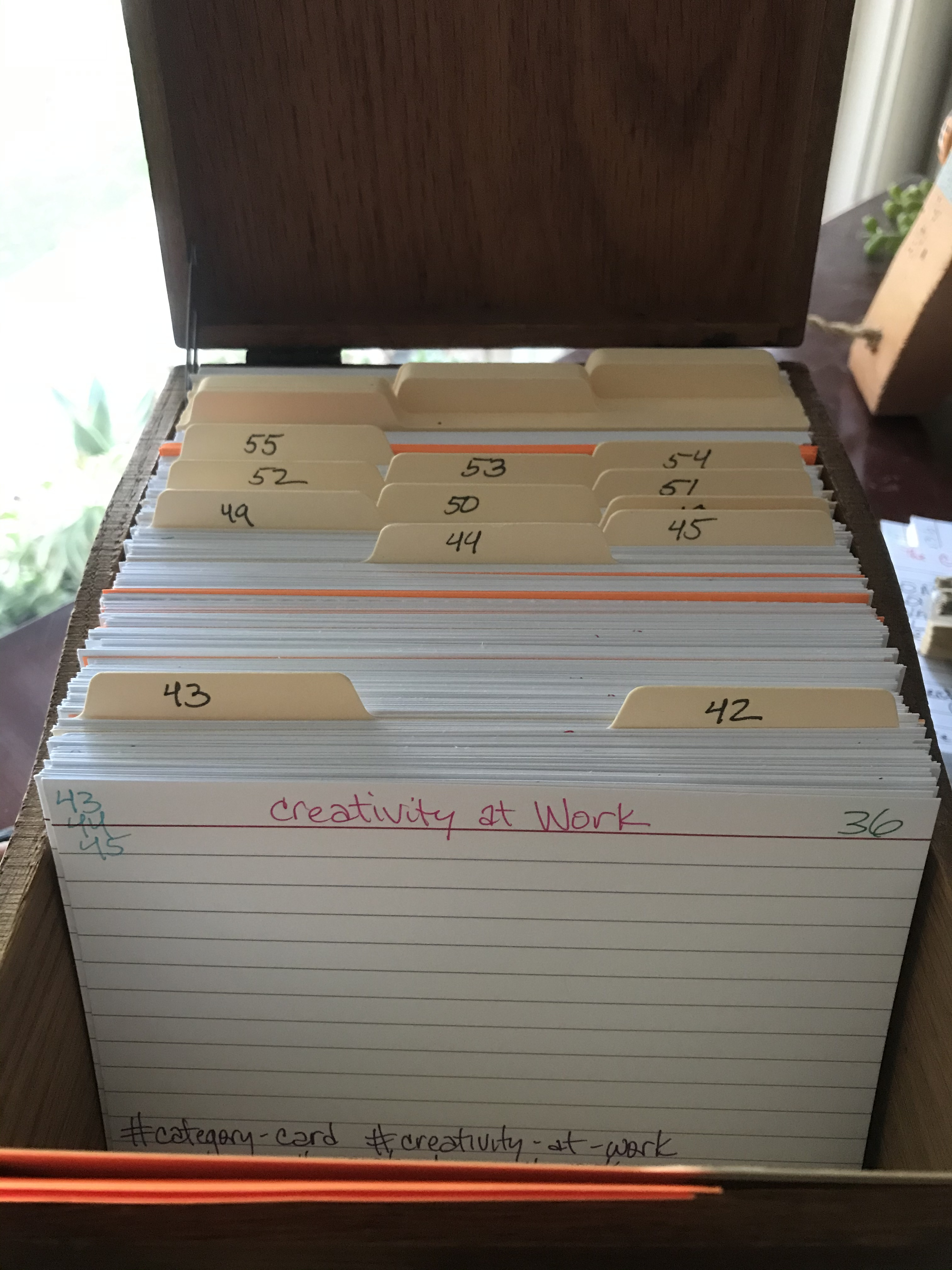
Within each of the main categories lie sub-categories. For "creativity", there are major sub-categories for definitions, models, ties to humanistic psychology, cultivating creativity, etc. (43a-d, etc.)
Running with the Creativity at Work category, though, there's a sub-category for elegance and innovation. On that card, I'm drawing from the literature to establish the concept.
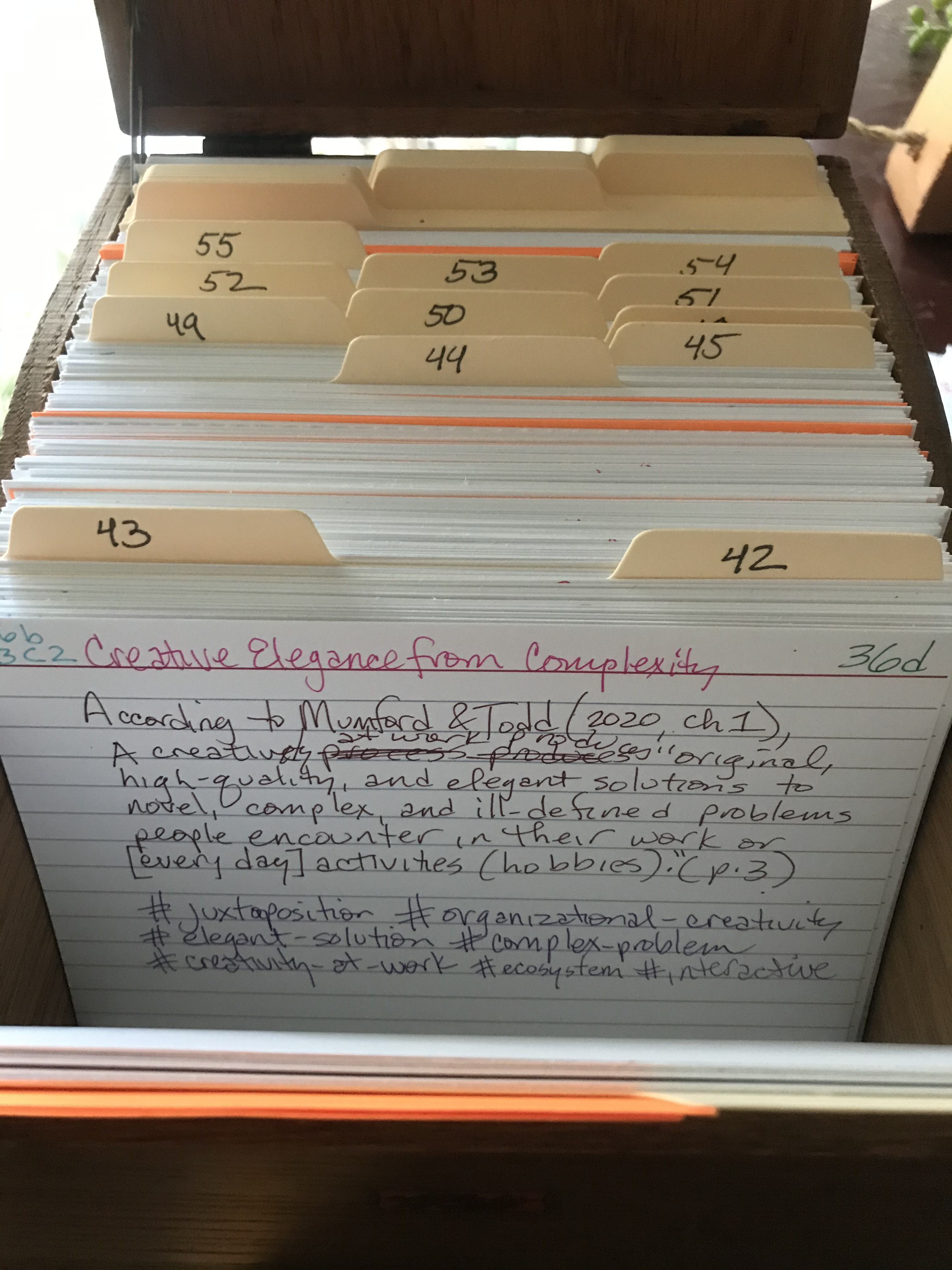
Within that sub-category are my own notes and thoughts on the subject:
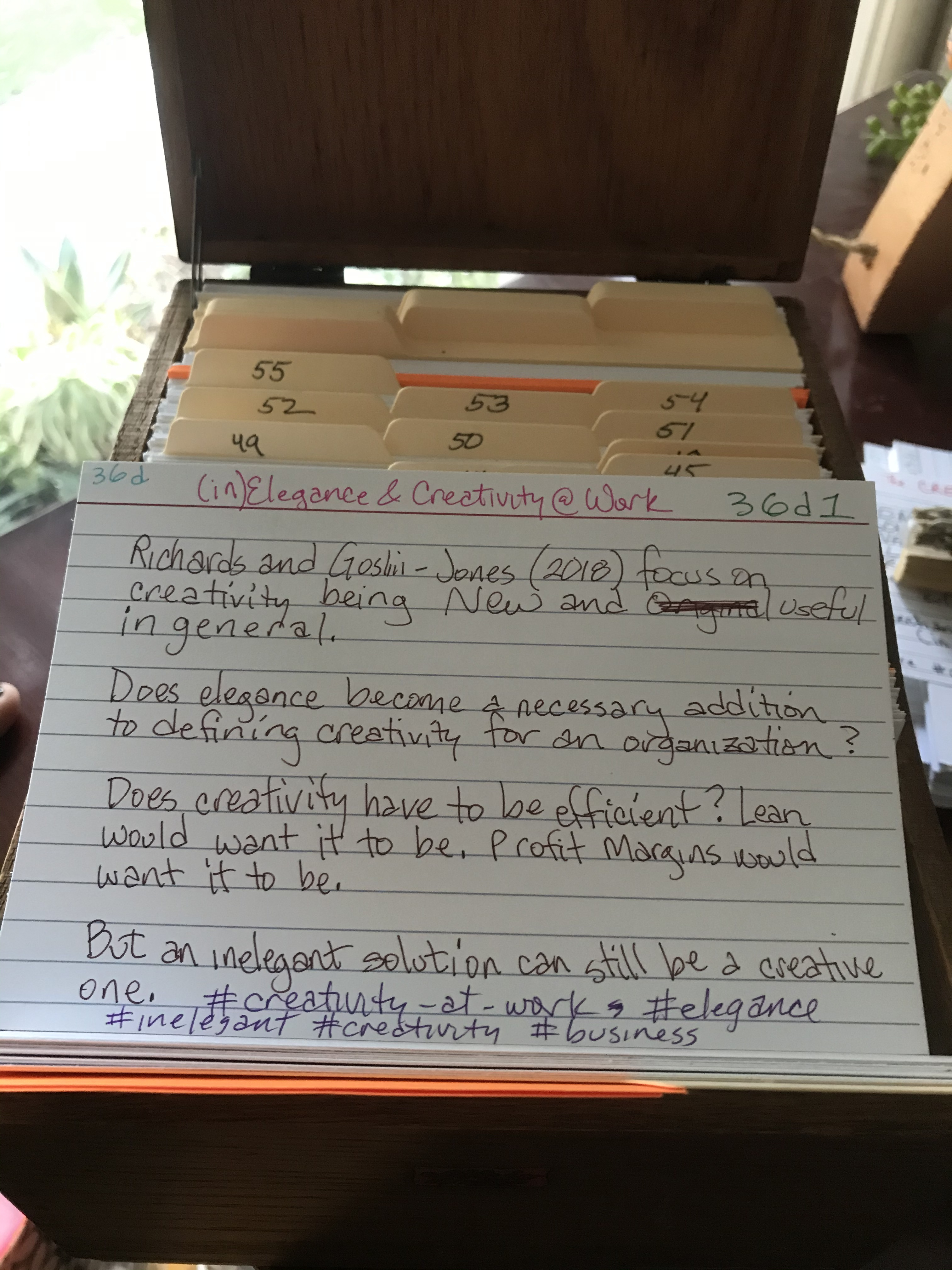
That sub-category card on elegance speaks to how I handle literature notes, now that I think about it. I don't create a "book report" literature note for each book or article I read, so much as notes for specific subjects addressed by the authors in the literature. My rationale for this is: when I'm writing my dissertation, I won't be doing a lit review of author's works, so much as authors' contributions to particular subjects (e.g. what did Richards say about everyday creativity, what did Wallas say about incubation, that sort of thing). Of course, for those primary authors more comprehensive reviews of their works would be called for. And of course, this may change or evolve over time.
And as for physical card updates - you nailed it. Pull 'em, update 'em, make sure Archive's got the info as well.
@jeannelking have you already written about why you decided to keep both a physical and digital zettelkasten? How is the content similar or different between the two? How do you use them differently?
I thought of doing this and like the idea, but stopped because it just seemed too time consuming. I thought maybe of doing a different type of zettelkasten for a physical. For example, I'd keep the notes on the cards very brief, and use it mainly as a way to track references in literature instead of developing ideas. Or just be very selective with what I put in the physical zettelkasten, but less selective in the digital zettelkasten.
@jeannelking Hi - from your most recent post, and the associated photos, it looks like you have created what is primarily a traditional system organized using categories, and then created a secondary system using Zettelkasten concepts, like connecting individual zettels (which could of course be across categories). Is that right or is my impression from your photos incorrect?
There is no reason this couldn't work as a completely legitimate Zettelkasten, but I'd be worried about being too directed by the primary system, i.e., the categories. I find the more organic way of adding zettels in a somewhat random manner, with the connections and ultimately the structure notes evolving organically, to suit my purposes. I'm not being critical though - I think there is a lot of room within the Zettelkasten concepts to evolve an organizational method and workflow that suits your own way of thinking and your own goals.
Thanks for sharing all the details and the photos! They will inspire many others.
I wrote about this very thing in a follow-up comment to this post:
https://forum.zettelkasten.de/discussion/1348/phd-student-reporting-what-its-like-to-use-a-zettelkasten-for-the-first-time-with-my-classes#latest
Content is similar between the two, although inspiration tends to come when I’m entering into the Archive.
Not gonna lie: it is time consuming. But for me, that’s part of the value: it forces me to slow down, to process, to think and digest.
On the nose, good sir!
I agree with you, and this is how many of my sub-categories (and main categories) emerge. I’m reading all these different things, let it sit, see new connections as I process and feed my ZK, slap myself on the forehead, and exclaim “duh, all this stuff’s really talking about THIS! Et voila: a new category or sub-category is born. (It’s how elegance became its own thing within creativity at work, just as an example.).
Absolutely. It’s one of the things I love about the concept and practice: I can look at - and learn from - all the different ways folks approach their ZKs, but at the end of the day my ZK will emerge just as plastic and organic and crazywonderful as my own brain. Because it’s an extension of my own brain. Let’s hear it for brains! 🧠 ❤️ 🎉 Woo!
@GeoEng51 I don't @jeannelking is off the mark, or at least not that far off it. Luhmann used some high level categories while also allowing for new categories to naturally emerge, as he could list and track them using the index. Here is a section from the Niklas Luhmann Archive
And then goes on to say
You can find Luhmann listing his 108 thematic departments, here. It is important to note that this is different from the subject index he kept.
In the archive description of the note box they further elaborate on this saying
and
So what I'd take away from all of this is that it is ok to use some high level categories with your note collection. This is a form of structure that can help you with tracking and guiding your research. The problem comes in when you become rigid with your categories, such that you fret over a place to put a note because it doesn't strictly fit into any one category. You just let the note become a branch from the note that sparked a new idea. If the new note is unrelated to the note it branched off of, you add a link to the index, so you will be able to find it again. Hope that helps a little bit.
I'd like to add to @Nick some practical thoughts: We people are eternal meaning seekers. Our brain is wired to see and produce patterns. Therefore, it is very unlikely that one can really tolerate a purely arbitrary system or produce it as Folgezettel is theoretically.
I am a Zettler
On a separate note (badum tish), @jeannelking I haven't commented on the actual zettelkasten yet! For comparison, here is my physical zettelkasten
Some thoughts
All in all, very cool! Thanks for sharing and keeping us updated on your ZK experiences.
When I see @jeannelking describing his/her own ZK slipbox on physical
book. I have a question: what's the benefit from using
non-digitalized format. Especially, it is in 2020 and @jeannelking has
the ability to chose the digital version of ZK.
When I listen to a podcast by Nicholas Carr: A podcast on deep
reading and digital thinking. I realize the benefit of using
non-digitalized ZK. It's is similar to what @jeannelking says:
This is one of the core ideas in the podcast: it is quality of the
connection between new information and the information one has that
matters. Often, building such high quality connection requires high
concentration and often more time.
According to the statistic data of my digital ZK usage, I am not able
to consistently produce 10+ ideas every day. Many times, I want to
write more and I go through some of the ideas I've generated, but the
reality is often the opposite. I am not sure that this is the main cause,
but at least I am aware of this now.
Podcast by Nicholas Carr: A poscast: on deep
reading and digital thinking.
ROFL
I'm digging your setup, @Nick. I really like how your prep caddy is right there with everything. That's something I might have to copy and steal - including my pens and tabs right in the box. (They're currently in two different locations in my desk.)
Thanks! Environment's a big thing for me and my productivity. My ZK started with rubber bands around some index cards for storage, but that got awkward in a hurry. A few evenings cruising Etsy listings and Voila! The boxes you see me using today.
Ordered them on Amazon - for 4"x6" index card files. SO glad I did!
I am also a fan of the giant index card. But they aren't just 4"x 6" index cards: they're extra heavy 4"x6" index cards! I chose this card because a) my handwriting can get big, and b) I plan to use these cards for three qualifying essays and my dissertation so they'd better be sturdy to keep up! :^) That said, your point about thinner cards makes me look at the desk box I've already filled up once, with 6+ semesters to go. I may need to consider a mix of thick and thin cards for bulk-management purposes...
@jeannelking yes, I think it largely depends on how long you plan on using it. Luhmann had two boxes over his career totaling around 90,000 cards. So if you imagine yourself getting that extensive of a collection, than slips of paper are a better bet. Paper is also more liable to have issues unfortunately and just don't feel as good as note cards.
I wonder if you could somehow use the mixing to your advantage. Like have official descriptions of concepts be on note cards, while commentary be on slips of paper?
I am really curious about your mid to long-term results with the analog version. There is very few experience with non-workaholics as far as I know it.
I am a Zettler
I will be sure to keep posting updates. ;^)
I have been searching for drawers to hold my Zettelkasten notes. The drawers you use seems to be perfect. Could you tell me where do you get those drawers?
Thanks @jeannelking for your sharing. I am finding it very helpful in working with my ZK set up. I have a very non-directed ZK set up which is helping me to gather and link lots of different things. I am wondering if you have challenges like any of the following:
I find when I am reading something and I come across something I want to capture and remember, that is easy to add to my ZK. But I find that I also want to keep other things (like list above).
One last thing - I tend to be very chronologically concerned - what I was reading when and what was the string of things that led me to this particular author or book or essay. That has tended to make me OVER DEPENDENT on trying to chronologically order things - did you ever have that tendency and if so, how did you deal with it.